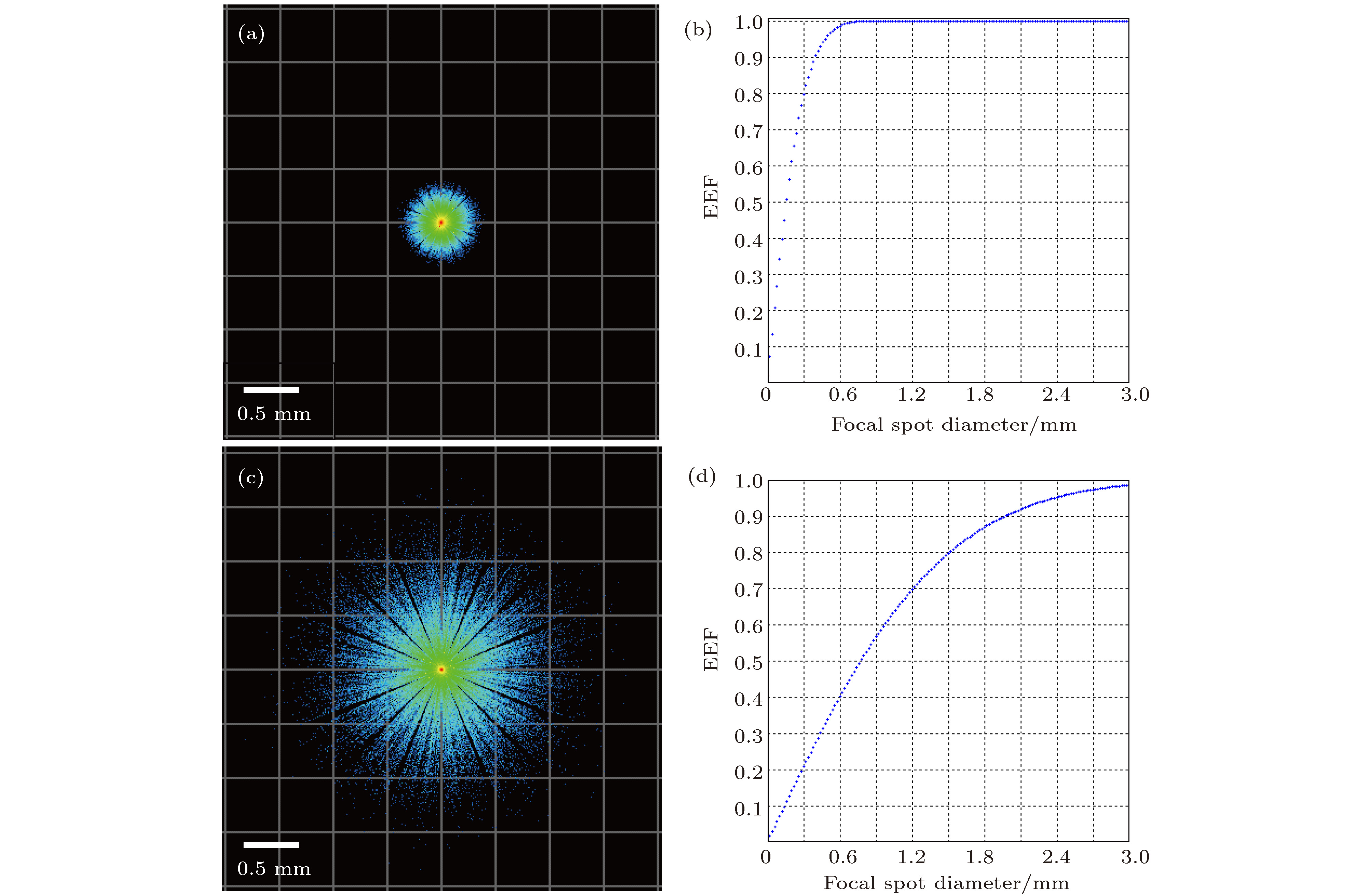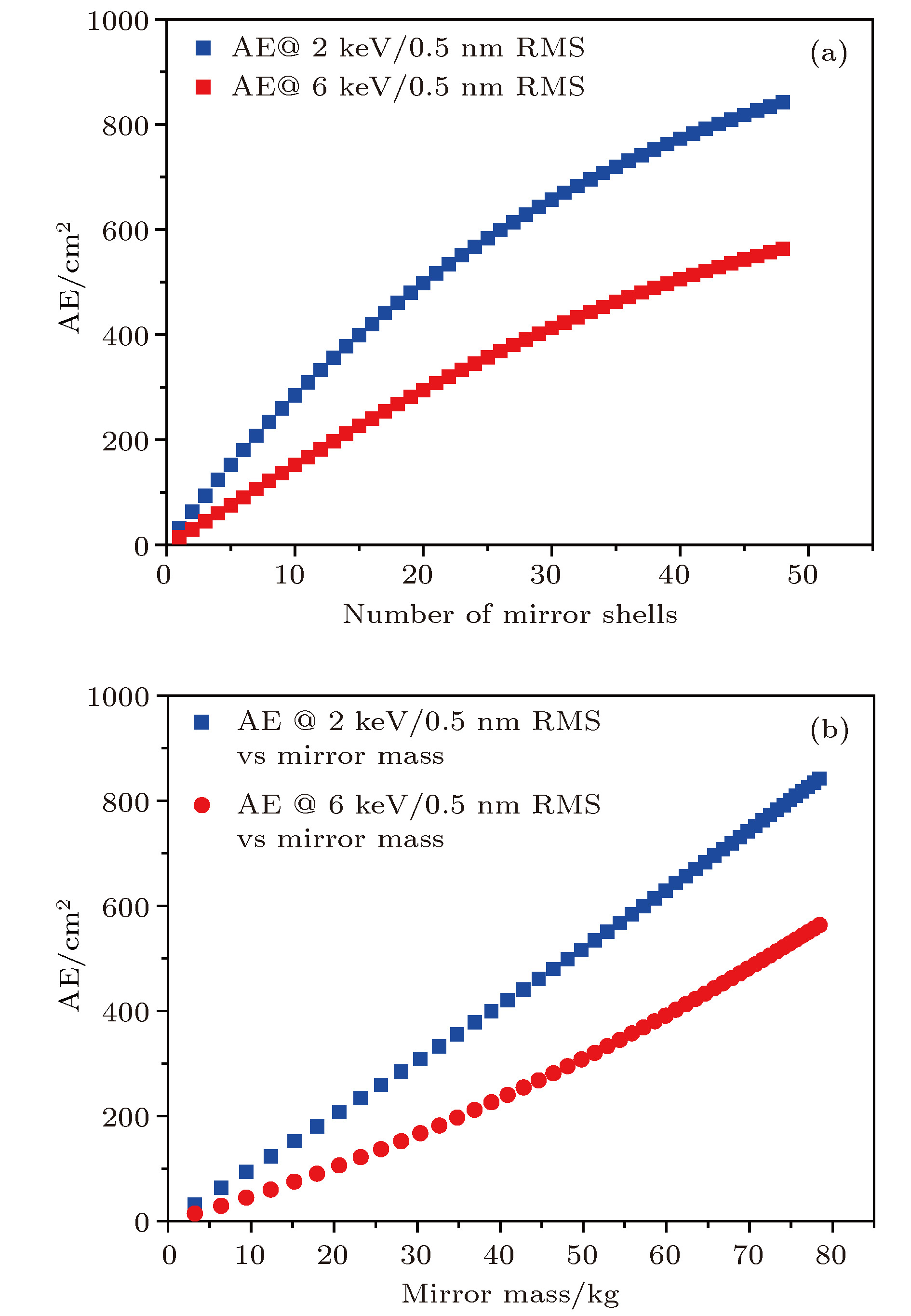-
X-ray focusing telescope is one of the most important equipment for X-ray space observation, which is designed based on the grazing incidence principle. The purpose of x-ray observation is to detect the black holes of various sizes in outer space, and the data obtained by X-ray telescope conduces to investigating the basic physical law under the condition of extreme gravity and magnetic field, In this article, multi-layer telescope is designed to satisfy the demand for enhanced X-ray timing and polarimetry mission. in which the telescope is designed based on Wolter-I telescope. The Monte Carlo method and power spectral density are used when the relationship between mirror profile and roughness with angular resolution is investigated. We analyze the relationship between angular resolution and mirror profile, and the result shows that the higher mirror profile possesses higher angular resolution. When the root mean square(RMS) of mirror profile is 0.04 μm, PV is 0.2 μm and roughness is 0.4 nm, the mirror angular resolution is 6.3" and it will change to 30.6" when the RMS of mirror profile is 0.2 μm, PV is 1 μm and roughness is 0.4 nm. The angular resolution out of focus is also investigated in this article, and the more defocusing amount gives rise to the worse angular resolution because defocusing spot will be larger than that of focal plane. So the maximum defocusing amount of 5 mm is required when the focal plane detector is installed. The relationship between effective area with film structure and layers number is also investigated. The film with Au mixed with C has a higher reflectivity than the film with only Au, because the mixed film will generate an interference effect and enhance the intensity of reflecting X-ray. When the telescope layers increase, the effective area and telescope weight are both improved, the requirement for effective area of satellite can be satisfied when the number of nesting layers is 45. However, when the number of nesting layers further increase, the effective area will be improved with a low speed, but the weight of telescope will increase with a high speed. The field of view of this telescope is 16′, which is more than the required value of 12′. Finally, the X-ray focusing telescope with 5.25 m focal length, 45 nesting layers, effective area 842 cm2 at 2 keV, 563 cm2 at 6 keV is obtained.
-
Keywords:
- X-ray /
- focusing observatory /
- grazing incidence principle /
- effective area /
- angular resolution
[1] Yuan W M, Zhang C, Chen Y. 2018 Sci. China: Phys. Mech. 48 3
[2] Jeong S, Panasyuk M I, Reglero V 2018 Space Sci. Rev. 214 25
 Google Scholar
Google Scholar
[3] Zhang S N, Santangelo A, Feroci M 2019 Sci. China Phys. Mech 62 25
[4] Zand J J M, Bozzo E, Qu J L 2019 Sci. China Phys. Mech. 62 029506
 Google Scholar
Google Scholar
[5] Camilo F, Scholz P, Serylak M 2018 Astrophys. J. 856 11
 Google Scholar
Google Scholar
[6] 刘舵, 强鹏飞, 李林森, 苏桐, 盛立志, 刘永安, 赵宝升. 2016 物理学报 65 010703
Liu D, Qiang P F, Li L S, Su T, Sheng L Z, Liu Y A, Zhao B S 2016 Acta Phys. Sin. 65 010703
[7] Li L S, Qiang P F, Sheng L Z 2017 Chin. Phys. B 26 100703
[8] 李林森, 强鹏飞, 盛立志, 刘哲, 周晓红, 赵宝升, 张淳民 2018 物理学报 67 200701
Li L S, Qiang P F, Sheng L Z, Liu Z, Zhou X H, Zhao B S, Zhang C M 2018 Acta Phys. Sin. 67 200701
[9] 方海燕, 丛少鹏, 孙海峰, 李小平, 苏剑宇, 张力, 沈利荣 2019 物理学报 68 089701
Fang H Y, Cong S P, Sun H F, Li X P, Su J Y, Zhanf L, Shen L R 2019 Acta Phys. Sin. 68 089701
[10] Sheikh S I, Hanson J E, Graven P H 2011 Navigation 58 165
 Google Scholar
Google Scholar
[11] Wang Y, Zheng W, Sun S 2013 Adv. Space Res. 51 2394
 Google Scholar
Google Scholar
[12] Weisskopf M C, Brinkman B, Canizares C 2002 Publ. Astron. Soc. Pac. 114 1
 Google Scholar
Google Scholar
[13] Starling R L C, Wildy C, Wiersema K 2017 Mon. Not. R. Astron. Soc. 468 378
 Google Scholar
Google Scholar
[14] Devasia J, Paul B 2018 Astrophys. Astron. 39 7
 Google Scholar
Google Scholar
[15] Bamba A, Puehlhofer G, Acero F 2012 Astrophys. J. 761 80
 Google Scholar
Google Scholar
[16] Kelley R L, Nakazawa K 2018 J. Astron. Telesc. Inst. 4 1
[17] Balsamo E, Gendreau K, Okajima T 2016 J. Astron. Telesc. Inst. 2 9
[18] Rao K R 1999 Curr. Sci. India 77 1125
[19] Tsujimoto M, Morihana K, Hayashi T 2018 Publ. Astron. Soc. Japan 70 14
[20] Hagino K, Nakazawa K, Sato G 2018 J. Astron. Telesc. Inst. 4 15
[21] Eckart M E, Adams J S, Boyce K R 2018 J. Astron. Telesc. Inst. 4 22
[22] Keek L, Arzoumanian Z, Bult P 2018 Astrophys J Lett. 855 6
 Google Scholar
Google Scholar
-
图 2 不同面型精度聚焦镜片的焦斑形状与能量包围函数 (a) RMS 0.04为 μm, PV为0.2 μm, 粗糙度为0.4 nm镜片的焦斑形状尺寸; (b) RMS为0.04 μm, PV为0.2 μm, 粗糙度为0.4 nm镜片的焦斑能量包围函数; (c) RMS为0.2 μm, PV为1 μm, 粗糙度为0.4 nm镜片的焦斑形状尺寸; (d) RMS为0.2 μm, PV为1 μm, 粗糙度为0.4 nm镜片的焦斑能量包围函数
Fig. 2. Focal points and energy encircle functions obtained by mirrors with different profile: (a) Focal point obtained by mirror with profile of RMS 0.04 μm, PV 0.2 μm, roughness 0.4 nm; (b) energy encircle functions obtained by mirror with profile of RMS 0.04 μm, PV 0.2 μm roughness 0.4 nm; (c) focal point obtained by mirror with profile of RMS 0.2 μm, PV 1 μm roughness 0.4 nm; (d) energy encircle functions obtained by mirror with profile of RMS 0.2 μm, PV 0.1 μm roughness 0.4 nm.
-
[1] Yuan W M, Zhang C, Chen Y. 2018 Sci. China: Phys. Mech. 48 3
[2] Jeong S, Panasyuk M I, Reglero V 2018 Space Sci. Rev. 214 25
 Google Scholar
Google Scholar
[3] Zhang S N, Santangelo A, Feroci M 2019 Sci. China Phys. Mech 62 25
[4] Zand J J M, Bozzo E, Qu J L 2019 Sci. China Phys. Mech. 62 029506
 Google Scholar
Google Scholar
[5] Camilo F, Scholz P, Serylak M 2018 Astrophys. J. 856 11
 Google Scholar
Google Scholar
[6] 刘舵, 强鹏飞, 李林森, 苏桐, 盛立志, 刘永安, 赵宝升. 2016 物理学报 65 010703
Liu D, Qiang P F, Li L S, Su T, Sheng L Z, Liu Y A, Zhao B S 2016 Acta Phys. Sin. 65 010703
[7] Li L S, Qiang P F, Sheng L Z 2017 Chin. Phys. B 26 100703
[8] 李林森, 强鹏飞, 盛立志, 刘哲, 周晓红, 赵宝升, 张淳民 2018 物理学报 67 200701
Li L S, Qiang P F, Sheng L Z, Liu Z, Zhou X H, Zhao B S, Zhang C M 2018 Acta Phys. Sin. 67 200701
[9] 方海燕, 丛少鹏, 孙海峰, 李小平, 苏剑宇, 张力, 沈利荣 2019 物理学报 68 089701
Fang H Y, Cong S P, Sun H F, Li X P, Su J Y, Zhanf L, Shen L R 2019 Acta Phys. Sin. 68 089701
[10] Sheikh S I, Hanson J E, Graven P H 2011 Navigation 58 165
 Google Scholar
Google Scholar
[11] Wang Y, Zheng W, Sun S 2013 Adv. Space Res. 51 2394
 Google Scholar
Google Scholar
[12] Weisskopf M C, Brinkman B, Canizares C 2002 Publ. Astron. Soc. Pac. 114 1
 Google Scholar
Google Scholar
[13] Starling R L C, Wildy C, Wiersema K 2017 Mon. Not. R. Astron. Soc. 468 378
 Google Scholar
Google Scholar
[14] Devasia J, Paul B 2018 Astrophys. Astron. 39 7
 Google Scholar
Google Scholar
[15] Bamba A, Puehlhofer G, Acero F 2012 Astrophys. J. 761 80
 Google Scholar
Google Scholar
[16] Kelley R L, Nakazawa K 2018 J. Astron. Telesc. Inst. 4 1
[17] Balsamo E, Gendreau K, Okajima T 2016 J. Astron. Telesc. Inst. 2 9
[18] Rao K R 1999 Curr. Sci. India 77 1125
[19] Tsujimoto M, Morihana K, Hayashi T 2018 Publ. Astron. Soc. Japan 70 14
[20] Hagino K, Nakazawa K, Sato G 2018 J. Astron. Telesc. Inst. 4 15
[21] Eckart M E, Adams J S, Boyce K R 2018 J. Astron. Telesc. Inst. 4 22
[22] Keek L, Arzoumanian Z, Bult P 2018 Astrophys J Lett. 855 6
 Google Scholar
Google Scholar
计量
- 文章访问数: 14881
- PDF下载量: 172
- 被引次数: 0














 下载:
下载:





